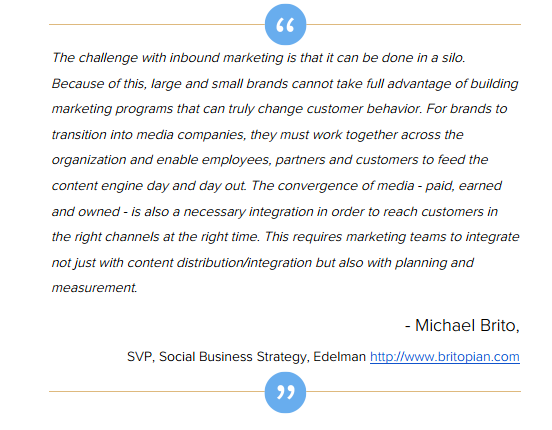 The best inbound marketing programs and the ones that create the most leads are not necessarily the ones that develop the most content or have the prettiest infographics. The most successful inbound marketing programs are the ones that embrace inbound marketing throughout the organization, and understand that in order to succeed it will take more than just the efforts of one person. An inbound culture differs from an outbound culture in that the expectation within an inbound culture is that the company’s website and blog will be sought out and found by our prospects, because of the great content that’s created rather than having to utilize outbound methods to attract prospects to their website.
The best inbound marketing programs and the ones that create the most leads are not necessarily the ones that develop the most content or have the prettiest infographics. The most successful inbound marketing programs are the ones that embrace inbound marketing throughout the organization, and understand that in order to succeed it will take more than just the efforts of one person. An inbound culture differs from an outbound culture in that the expectation within an inbound culture is that the company’s website and blog will be sought out and found by our prospects, because of the great content that’s created rather than having to utilize outbound methods to attract prospects to their website.
In a very basic sense, an inbound culture understands that the very core of their existence is based upon trying to solve their prospect’s needs and explaining to them in a non-sales oriented way how they can do that for them.
There are several characteristics that successful inbound marketing organizations share and we have listed our top 5 below.
5 Characteristics of an Inbound Marketing Culture
1) A Champion Must Emerge
A champion in the broadest sense of the term doesn’t have to necessarily be someone at the top of the organization hierarchy. As a champion of your organization’s inbound marketing efforts this person has to have the desire, knowledge and empowerment from management to move the inbound efforts forward. We typically call this person the Blog Manager and is the one at the heart of the inbound marketing program to coordinate all of the activities that go into inbound marketing. One of these tasks that doesn’t go unnoticed is being a cheerleader for the inbound efforts and working with other team members to assist in generating content for the blog. This inbound champion routinely sends out reminders that new blog posts are needed and highlight successes that have occurred. They are the glue that holds the inbound efforts together and without a good one the chance of success is slim.

2) Create Content
Inbound marketing is also known as “content marketing” for a reason. The way to generate inbound leads is by creating remarkable content that brings visitors to your website. Determining which type of content resonates best with your target audience, or persona, is an important first step so you know what type of content to create. Does your target audience respond better to videos, podcasts, whitepapers or webinars? Regardless of the medium that you use to provide your content it’s important that you publish consistently and frequently to insure success.
3) Share Content
Creating remarkable content enough to create a successful inbound marketing program. The old adage “if a tree falls in the woods and no one hears it did it really make a noise” comes to mind. Or, “if you build it they will come.” Both of these wise sayings speak to the social nature of content marketing, and how in order for your content to really reach your target audience you will have to share you content on social networks such as LinkedIn, Facebook, Twitter and Google+.
In an inbound culture this sharing doesn’t take place from just the corporate or blog’s social media networks... it is shared by all employees of the company whether directly from their social networks or by rebroadcasting the corporate posts.
For instance... in companies where employees don’t share on their own social media networks, the inbound efforts are not as successful and take longer to ramp up. In companies that have employees that embrace social media and share the company’s posts on their social networks there is much more social traffic to the blog and leads generated.
It is important to note that the sharing by employees needs to be on the appropriate networks. For instance, it might not help too much if employees share updates on their personal Facebook pages if they are not actively using Facebook for business purposes. Let’s face it your employees’ friends might not care too much about your latest blog post. However, on Twitter and LinkedIn, which can sometimes have a more business orientation, your employees’ sharing the company’s posts can be very impactful.
4) Engage Socially
Having your employees syndicate (simply publish to their own social media networks) while effective, isn’t the best way to gain traction in the social sphere. If you are simply sending messages out, but never engaging (responding or commenting on) in social media, you create a very one-way form of social media. It’s actually a rather outbound form of social media since you are not necessarily trying to bring people to your site but blast them your messages.
Making sure that you and those engaging in social media are monitoring social media, responding to comments and thanking others for sharing is a great start at creating a two-way dialogue.
5) Smarketing
Collaboration and partnership between Sales and Marketing at companies with an inbound culture is usually greater. According to HubSpot’s State of Inbound 2013, nearly 75% of companies with a formal marketing-sales agreement implemented inbound in 2013.
This alignment of sales and marketing around an agreed upon SLA, (Service Level Agreement) has been coined by HubSpot as Smarketing.
Companies that are looking to get started with inbound marketing, or are already involved with inbound marketing, should make sure to focus on creating an inbound culture versus simply starting an inbound program without a shift in culture. Companies that don’t change the way they think and market without truly embracing (should inbound marketing be inserted here) will face an uphill battle and a higher chance of failure.
If you want to learn more about creating an inbound culture at your company, download our 30 Days to Inbound Marketing Success.


